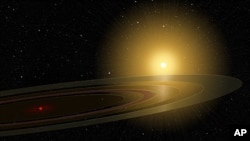An international team of astrophysicists has identified the first object outside our solar system with an extensive system of rings similar to those surrounding Saturn, the sixth planet from our sun.
The scientists were analyzing 54 days' worth of puzzling deep-space images collected by a global network of special telescopes when they realized they had discovered a colossal set of dusty rings with a diameter spanning tens of millions of kilometers. By comparison, Saturn’s icy rings measure a mere 300,000 kilometers across.
The newly-discovered rings of dust and other cosmic debris surround a mysterious object that orbits a relatively young, sun-like star in a system located 420 light years from Earth.
Lead scientist Eric Mamajek of Rochester University in New York says it could be a huge gas-giant planet, a small low-mass star, or a type of failed star called a brown dwarf. More data to calculate the object’s mass is needed before they can determine what it is. He says another intriguing mystery is the source of two pronounced gaps separating the enormous outermost rings, which may suggest the late stages of planet formation or the formation of moons.
The worldwide network of telescopes used to make the new discovery is part of the international Super-WASP and ASAS projects, which search outer space for new planets. WASP stands for Wide Angle Search for Planets. ASAS stands for All Sky Automated Survey. In late 2010, the scientists began analyzing the data the telescopes first collected in 2007.
The new findings of the Rochester University-led study will be published in an upcoming issue of The Astronomical Journal.
Some information for this report was provided by AP, AFP and Reuters.












